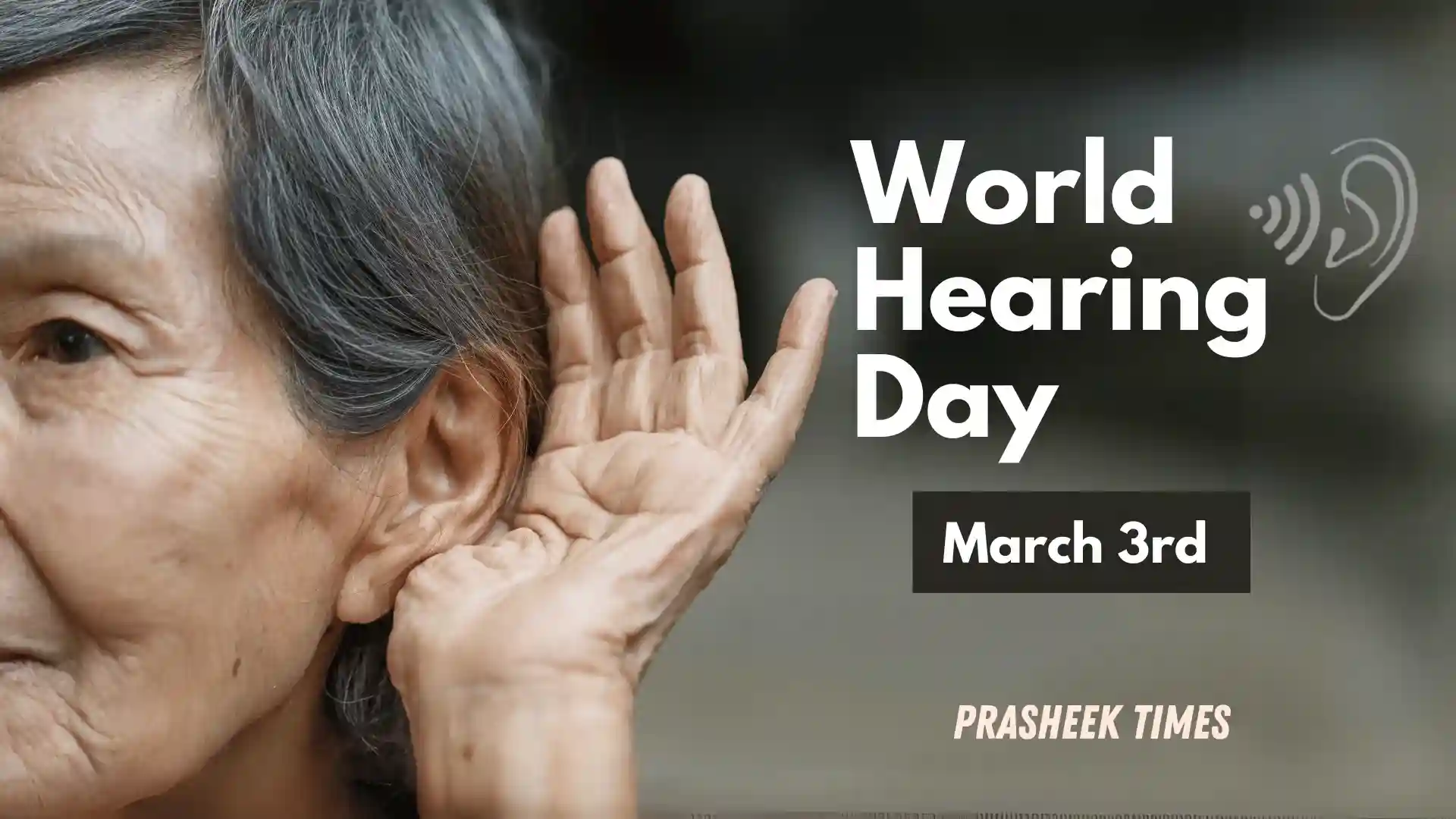Introduction:
World Hearing Day, observed annually on March 3rd, serves as a global platform to raise awareness about hearing loss and promote ear and hearing care. As we commemorate this important day, it is crucial to delve deeper into the significance of hearing health, the causes and consequences of hearing loss, and strategies for prevention and management.
Understanding Hearing Loss:
Loss is a prevalent sensory impairment affecting millions of individuals worldwide. According to the World Health Organization (WHO), over 5% of the global population – approximately 466 million people – experience disabling hearing loss. This statistic encompasses individuals of all ages, from infants to the elderly, highlighting the widespread nature of this health issue.

Causes of Hearing Loss:
It can result from various factors, including genetic predisposition, aging (presbycusis), exposure to loud noises (noise-induced hearing loss), ototoxic medications, infections (such as otitis media), and diseases (e.g., Meniere’s disease). Prolonged exposure to excessive noise levels, whether in occupational settings (e.g., construction sites, factories) or recreational environments (e.g., concerts, sporting events), remains one of the leading causes of preventable hearing loss globally.

Consequences of Untreated PRoblem:
The consequences of untreated hearing loss extend beyond the impairment of auditory perception. Individuals with untreated hearing loss often face challenges in communication, leading to difficulties in social interactions, academic performance, and employment opportunities. Moreover, untreated hearing loss has been linked to an increased risk of cognitive decline, dementia, and mental health disorders, underscoring the far-reaching impact of this condition on overall well-being.
Prevention and Management:
While some forms of hearing loss are inevitable due to genetic predisposition or age-related changes, many cases can be prevented through effective interventions. Prevention strategies include promoting awareness of hearing health, implementing noise control measures in workplaces and communities, and encouraging the use of hearing protection devices (e.g., earplugs, earmuffs) in noisy environments. Early detection of hearing loss through regular screenings and comprehensive audiological evaluations is essential for timely intervention and management. Treatment options may include hearing aids, cochlear implants, assistive listening devices, and auditory rehabilitation programs tailored to individual needs.
Promoting Hearing Health:
World Hearing Day serves as a catalyst for global action to address loss to ear and hearing care. Organizations, healthcare professionals, policymakers, and communities collaborate to raise awareness, advocate for equitable access to hearing healthcare services, and implement evidence-based interventions. Public awareness campaigns, educational initiatives, and community outreach programs play a pivotal role in empowering individuals to prioritize their hearing health and seek timely interventions when needed.
Expanded Information:
Hearing loss, also known as hearing impairment or deafness, can manifest in various forms and degrees of severity. It can affect one or both ears, and the extent of impairment can range from mild to profound. Understanding the different types of hearing loss and their underlying causes is essential for effective prevention, diagnosis, and management.
Types of Hearing Loss:
- Conductive Loss: This type of hearing loss occurs when sound waves cannot effectively pass through the outer or middle ear to reach the inner ear. Common causes include blockages in the ear canal (e.g., earwax buildup), middle ear infections (otitis media), fluid accumulation behind the eardrum (effusion), or structural abnormalities (e.g., malformation of the ear ossicles).
- Sensorineural Loss: Sensorineural hearing loss results from damage to the inner ear (cochlea) or the auditory nerve pathways connecting the inner ear to the brain. It is often caused by aging (presbycusis), exposure to loud noises (noise-induced hearing loss), genetic factors, ototoxic medications, or diseases such as Meniere’s disease or autoimmune inner ear disease.
- Mixed Loss: Mixed loss involves a combination of conductive and sensorineural components, affecting both the outer/middle ear and the inner ear or auditory nerve. This type of hearing loss may result from a combination of factors, such as chronic ear infections leading to permanent damage to the middle ear structures and underlying sensorineural impairment.
- Auditory Processing Disorders (APD): APDs affect the brain’s ability to interpret and process auditory information effectively, even when hearing sensitivity is within the normal range. Individuals with APDs may experience difficulties understanding speech in noisy environments, following directions, or discriminating between similar sounds.
- Central Auditory Processing Disorder (CAPD): CAPD specifically refers to deficits in the central nervous system’s ability to process auditory information. It can manifest as difficulties with auditory attention, auditory discrimination, auditory memory, or sound localization, despite normal peripheral hearing function.
Identifying the specific type and underlying cause of hearing loss is essential for developing targeted interventions and treatment plans tailored to individual needs. Audiological assessments, including comprehensive hearing evaluations, pure-tone audiometry, speech audiometry, and auditory processing tests, are instrumental in diagnosing hearing loss and guiding appropriate management strategies.

Impact of Hearing Loss:
The consequences of loss extend beyond the auditory domain, affecting various aspects of an individual’s life and overall well-being. Some of the key impacts of untreated hearing loss include:
- Communication Challenges: Hearing loss can impair an individual’s ability to understand speech, particularly in noisy environments or during conversations with multiple speakers. This can lead to frustration, misunderstandings, and social withdrawal, as individuals may avoid social gatherings or struggle to engage in meaningful interactions with others.
- Educational Limitations: Children with untreated hearing loss may experience delays in speech and language development, academic performance, and social integration. Hearing impairment can affect their ability to learn and communicate effectively in educational settings, potentially hindering their academic success and future opportunities.
- Psychosocial Effects: Untreated hearing loss has been associated with an increased risk of anxiety, depression, social isolation, and diminished quality of life. Individuals may experience feelings of loneliness, self-consciousness, or inadequacy due to their hearing impairment, leading to emotional distress and psychological challenges.
- Cognitive Decline: Growing evidence suggests a link between untreated hearing loss and cognitive decline, including an increased risk of dementia and Alzheimer’s disease. The cognitive load associated with struggling to hear and understand speech may contribute to cognitive fatigue, accelerated cognitive decline, and changes in brain structure and function over time.
- Economic Burden: It can have significant economic implications for individuals, families, and society as a whole. The costs associated with untreated loss may include expenses related to healthcare services, assistive devices (e.g., hearing aids, cochlear implants), educational support, and lost productivity in the workplace.
Addressing the impact requires a comprehensive approach that encompasses early detection, timely intervention, and ongoing support for individuals with hearing impairment. Multidisciplinary teams, including audiologists, otolaryngologists, speech-language pathologists, educators, and mental health professionals, play a critical role in providing holistic care and support to individuals with hearing loss and their families.
Prevention Strategies:
While some forms of hearing damage are unavoidable due to genetic predisposition or age-related changes, many cases can be prevented through proactive measures. Key prevention strategies include:
- Protecting Against Noise-Induced : Limit exposure to loud noises and use hearing protection devices (e.g., earplugs, earmuffs) in noisy environments, such as concerts, sporting events, construction sites, and recreational activities (e.g., shooting, motorcycling).
- Promoting Healthy Hearing Habits: Encourage individuals to adopt healthy hearing habits, such as reducing the volume when listening to music or using headphones, taking regular breaks from noisy environments, and avoiding recreational activities with excessive noise levels.
- Educating About Ear Care: Raise awareness about the importance of ear care and hygiene practices, including avoiding the use of cotton swabs or other objects to clean the ears, seeking timely treatment for ear infections, and protecting the ears from water exposure during swimming or bathing.
- Screening for Hearing Loss: Implement universal newborn hearing screening programs to identify hearing impairment in infants early and facilitate timely intervention and support. Additionally, promote regular hearing screenings for individuals of all ages, particularly those at higher risk due to occupational noise exposure, medical conditions, or genetic predisposition.
- Advocating for Noise Control: Advocate for policies and regulations aimed at reducing noise pollution in workplaces, communities, and public spaces. Support initiatives to develop quieter technologies, implement noise abatement measures, and raise awareness about the health risks associated with excessive noise exposure.
Management Strategies:
For individuals already experiencing ear damage, timely intervention and appropriate management strategies are essential for optimizing communication, minimizing the impact of hearing impairment, and enhancing quality of life. Management options may include:
- Hearing Aids: Hearing aids are electronic devices designed to amplify sounds and improve speech intelligibility for individuals with mild to moderate hearing loss. Modern hearing aids come in various styles, sizes, and technology levels to suit individual preferences and hearing needs.
- Cochlear Implants: Cochlear implants are surgically implanted electronic devices that bypass damaged or non-functional parts of the inner ear (cochlea) and directly stimulate the auditory nerve to transmit sound signals to the brain. Cochlear implants are typically recommended for individuals with severe to profound hearing loss who do not benefit from conventional hearing aids.
- Assistive Listening Devices (ALDs): ALDs are specialized devices designed to enhance auditory communication and accessibility for individuals with hearing loss. Examples include personal amplifiers, FM systems, loop systems, infrared systems, and captioned telephones, which can improve speech clarity and reduce background noise in various listening situations.
- Auditory Rehabilitation: Auditory rehabilitation programs aim to improve communication skills, auditory processing abilities, and overall functional outcomes for individuals with hearing loss. These programs may include speech and language therapy, auditory training, communication strategies, and psychosocial support to address the cognitive, linguistic, and emotional aspects of hearing impairment.
- Communication Strategies: Encourage individuals with hearing loss and their communication partners to implement effective communication strategies to optimize interactions and minimize communication barriers. Strategies may include facing the speaker, maintaining eye contact, speaking clearly and slowly, using visual cues or gestures, and reducing background noise whenever possible.
- Psychosocial Support: Provide emotional support, counseling, and resources to individuals and families coping with the psychosocial challenges associated with hearing loss. Peer support groups, online communities, and mental health services can offer valuable support networks and coping strategies for managing the emotional impact of hearing impairment.

Global Initiatives and Advocacy Efforts:
World Hearing Day serves as a global platform to advocate for ear and hearing care, promote awareness of hearing health, and mobilize stakeholders to address the burden of hearing loss worldwide. International organizations, governments, non-governmental organizations (NGOs), healthcare professionals, and community leaders collaborate to implement evidence-based interventions and policy initiatives aimed at:
- Raising Awareness: Organize public awareness campaigns, educational events, and media initiatives to increase understanding of hearing loss, its causes, consequences, and prevention strategies. Use digital platforms, social media, and traditional media channels to disseminate information and engage diverse audiences in the conversation about hearing health.
- Promoting Access to Hearing Healthcare: Advocate for equitable access to comprehensive hearing healthcare services, including preventive care, diagnostic evaluations, treatment options, and rehabilitation programs. Support initiatives to improve affordability, availability, and accessibility of hearing aids, cochlear implants, and assistive devices for individuals with hearing loss, particularly in low-resource settings.
- Strengthening Healthcare Systems: Strengthen healthcare infrastructure, workforce capacity, and service delivery systems to ensure timely diagnosis, intervention, and follow-up care for individuals with hearing loss. Invest in training programs for audiologists, otolaryngologists, speech-language pathologists, and allied healthcare professionals to enhance their skills in diagnosing, treating, and managing hearing impairment effectively.
- Integrating Hearing Health into Public Health Initiatives: Integrate hearing health promotion and prevention efforts into broader public health agendas, such as maternal and child health programs, aging populations, disability inclusion, and non-communicable disease prevention. Collaborate with stakeholders across sectors, including education, employment, transportation, and urban planning, to create supportive environments and policies that prioritize ear and hearing care.
- Supporting Research and Innovation: Invest in research, innovation, and technology development to advance our understanding of hearing loss, develop novel interventions, and improve the effectiveness and accessibility of hearing healthcare services. Foster collaborations between academia, industry, and healthcare institutions to accelerate the translation of scientific discoveries into clinical practice and public health impact.
WHO Theme foe World Hearing Day 2024:
World Hearing Day 2024 will focus on overcoming the challenges posed by societal misperceptions and stigmatizing mindsets through awareness-raising and information-sharing, targeted at the public and health care providers.
The theme for World Hearing Day 2024 is “Let’s make ear and hearing care a reality for all!”
Key messages:
- Globally, over 80% of ear and hearing care needs remain unmet.
- Unaddressed hearing loss poses an annual cost of nearly US$1 trillion globally.
- Deeply ingrained societal misperceptions and stigmatizing mindsets are key factors that limit efforts for preventing and addressing hearing loss.
- Changing mindsets related to ear and hearing care is crucial to improving access and mitigating the cost of unaddressed hearing loss.
World Hearing Day 2024 will be observed with the following objectives:
- Counter the common misperceptions related to ear and hearing problems in communities and among health care providers.
- Provide accurate and evidence-based information to change public perceptions of ear and hearing problems.
- Call on countries and civil society to address misperceptions and stigmatizing mindsets related to hearing loss, as a crucial step towards ensuring equitable access to ear and hearing care.
Conclusion:
World Hearing Day serves as a call to action to address the global burden of hearing loss and promote ear and hearing care as essential components of public health. By raising awareness, advocating for policy change, and mobilizing resources and stakeholders, we can empower individuals to protect their hearing, seek timely interventions, and access the support they need to thrive. Let us join hands in celebrating Hearing Day and committing to a future where everyone can enjoy the sounds of life to the fullest extent possible.
Statistics:
- Over 5% of the global population – approximately 466 million people – experience disabling hearing loss, according to the WHO.
- The prevalence of hearing loss is expected to rise due to factors such as population aging and increased exposure to noise pollution.
- Untreated hearing loss is associated with communication difficulties, social isolation, cognitive decline, and mental health disorders.
- Early detection and intervention are critical for effectively managing hearing loss and minimizing its impact on individuals’ lives.
Happy Reading!



